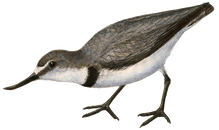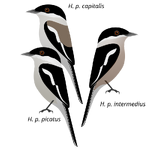| Ibis | |
|---|---|
| File:Threskiornis spinicollis-fragment.jpg | |
| Straw-necked Ibis | |
| Scientific classification | |
| Kingdom: | Animalia |
| Phylum: | Chordata |
| Class: | Aves |
| Order: | Pelecaniformes |
| Family: | Threskiornithidae |
| Subfamily: | Threskiornithinae Poche, 1904 |
| Genera | |
The ibises (collective plural ibis;[1] classical plurals ibides[2][3] and ibes[3]) are a group of long-legged wading birds in the family Threskiornithidae.
They all have long down curved bills, and usually feed as a group, probing mud for food items, usually crustaceans. Most species nest in trees, often with spoonbills or herons.
The word ibis comes from Greek and Latin, and probably from the Ancient Egyptian.[4] According to Josephus, Moses employed ibes against flying serpents during a desert campaign into Ethiopia in his early life.[5] Pliny the Elder also recounted, “The Egyptians invoked [ibes] against the flying serpents.” [6]
Species in taxonomic order[]
There are 28 extant species and 2 extinct species of ibis.
- Genus Threskiornis
- African Sacred Ibis, Threskiornis aethiopicus
- Malagasy Sacred Ibis, Threskiornis bernieri
- †Reunion Ibis, Threskiornis solitarius (extinct)
- Black-headed Ibis, Threskiornis melanocephalus
- Australian White Ibis, Threskiornis molucca
- Straw-necked Ibis, Threskiornis spinicollis
- Genus Pseudibis
- Red-naped Ibis, Pseudibis papillosa
- White-shouldered Ibis, Pseudibis davisoni
- Giant Ibis, Pseudibis gigantea
- Genus Geronticus
- Northern Bald Ibis, Geronticus eremita
- Southern Bald Ibis, Geronticus calvus
- Genus Nipponia
- Crested Ibis, Nipponia nippon
- Genus Bostrychia
- Olive Ibis, Bostrychia olivacea
- Sao Tome Ibis, Bostrychia bocagei
- Spot-breasted Ibis, Bostrychia rara
- Hadada Ibis, Bostrychia hagedash
- Wattled Ibis, Bostrychia carunculata
- Genus Theristicus
- Plumbeous Ibis, Theristicus caerulescens
- Buff-necked Ibis, Theristicus caudatus
- Black-faced Ibis, Theristicus melanopis
- Genus Cercibis
- Sharp-tailed Ibis, Cercibis oxycerca
- Genus Mesembrinibis
- Green Ibis, Mesembrinibis cayennensis
- Genus Phimosus
- Bare-faced Ibis, Phimosus infuscatus
- Genus Eudocimus
- American White Ibis, Eudocimus albus
- Scarlet Ibis, Eudocimus ruber
- Genus Plegadis
- Glossy Ibis, Plegadis falcinellus
- White-faced Ibis, Plegadis chihi
- Puna Ibis, Plegadis ridgwayi
- Genus Lophotibis
- Madagascar Ibis, Lophotibis cristata
- Genus Threskiornis
An extinct species, the Jamaican Ibis or Clubbed-wing Ibis (Xenicibis xympithecus) was uniquely characterized by its club-like wings.
In culture[]
The African Sacred Ibis was an object of religious veneration in ancient Egypt, particularly associated with the god, Thoth. At the town of Hermopolis, ibises were reared specifically for sacrificial purposes and in the Serapeum at Saqqara, archaeologists found the mummies of one and a half million ibises and hundreds of thousands of falcons.[7]
According to local legend in the Birecik area, the Northern Bald Ibis was one of the first birds that Noah released from the Ark as a symbol of fertility,[8] and a lingering religious sentiment in Turkey helped the colonies there to survive long after the demise of the species in Europe.[9]
The mascot of the University of Miami is an American White Ibis. The ibis was selected as the school mascot because of its legendary bravery during hurricanes. According to legend, the ibis is the last sign of wildlife to take shelter before a hurricane hits and the first to reappear once the storm has passed.[10]
A short story The Scarlet Ibis by James Hurst uses the sable-hued bird as foreshadowing for a character's death and as the primary symbol.[11]
The African Sacred Ibis is the unit symbol of the Israeli Special Forces unit known as Unit 212 or Maglan in Hebrew: מגלן.
Species images[]
References[]
- ^ "ibis". Dictionary.com Unabridged. Retrieved 6 October 2009.
- ^ C. A. M. Fennell, ed. (1892). The Stanford dictionary of Anglicised words and phrases. Cambridge: Cambridge University Press. p. 453. OCLC 1354115. Retrieved 6 October 2009.
- ^ a b Pierce, Robert Morris (1910). Dictionary of Hard Words. New York: Dodd, Mead & Company. p. 270. OCLC 4177508. Retrieved 6 October 2009.
- ^ Chambers Dictionary
- ^ Josephus, Flavius and William Whiston. The Works of Josephus : Complete and Unabridged. Peabody: Hendrickson, 1996, "Antiquities" 2.246.
- ^ Josephus, Flavius and William Whiston. The Works of Josephus : Complete and Unabridged. Peabody: Hendrickson, 1996, "Antiquities" 2.246, footnote referencing Natural History (Pliny) 10.28.
- ^ Fleming, Furgus; Alan Lothian; Duncan Baird Publishers. The Way to Eternity: Egyptian Myth. Amsterdam: Time-Life Books. 1997. pp. 66-67
- ^ Shuker, Karl (2003). The Beasts That Hide from Man: Seeking the World's Last Undiscovered Animals. Cosimo. pp. 166–168. ISBN 1931044643. "Dreams of a feathered Geronticus"
- ^ Beintema, Nienke. "Saving a charismatic bird" (PDF). AEWA Secretariat. Retrieved 11 December 2008.
- ^ Hurricane sports
- ^ The Scarlet Ibis
External links[]
- Ibis videos - at Internet Bird Collection
| Wikimedia Commons has media related to: http://commons.wikimedia.org/wiki/Category:Pseudibis |
| |||||||||||||||||||||||||||||||||||||||||||||||||||||||||||||
| This page uses Creative Commons Licensed content from Wikipedia (view authors). Please help by writing it in the style of All Birds Wiki! |

|
This article is part of Project Bird Subfamilies, a All Birds project that aims to write comprehensive articles on each bird subfamily, including made-up families. |

|
This article is part of Project Bird Taxonomy, a All Birds project that aims to write comprehensive articles on every order, family and other taxonomic rank related to birds. |
